Lindsay McCray is young with short dark hair and glasses framing her big blue eyes. She sits down in a conference room on the sixth floor of the Provincial Court in between meetings at work. Looking at McCray you wouldn’t know she spent 20 years dealing with severe pain — popping handfuls of Advil and Tylenol, eventually moving to a mild opioid and stashing heating pads near every outlet she could.
McCray suffers from endometriosis, a painful disease in which tissue that normally lines the inside of your uterus — the endometrium — grows outside your uterus.
Like many women living with endometriosis, the North Saanich resident didn’t know she had the disease until she had already spent 20 years dealing with the pain, which she describes as leaving her whole pelvis feeling like it had barbed wire in it. The disease affects one in 10 women but often takes many years before being diagnosed due to the lack of awareness surrounding it.
“If you’re in pain like that one or two days a month it’s not so bad, but when it’s three weeks of every month, it really starts to wear you down,” says the Victoria resident.
For years McCray would go straight to bed after work, watching her children’s youth pass her by as she was in too much pain to do much of anything. She credits her husband for taking care of everything during this time.
READ ALSO: Struggling Vancouver Island family needs help after baby born two months premature
About two years ago, McCray was seeing a nurse practitioner for an unrelated matter when the nurse turned to her and said, ‘You don’t look good,’ the beginning of a conversation that would change McCray’s life.
That’s when she was first told she might have endometriosis. McCray recalls the moment as validating and infuriating at the same time.
“You go through this mental process of not believing yourself and to hear the condition had a name and I wasn’t crazy — that was pretty revolutionary for me,” she says.
Dr. Catherine Allaire, medical director at the B.C. Women’s Hospital Centre for Pelvic Pain and Endometriosis, says the disease is difficult to diagnose due to a lack of non-invasive methods, adding they usually don’t provide a full cure.
She says more work needs to be done to increase awareness not only in the general public but at the health care level as well.
“If a young woman has debilitating menstrual cramps that are affecting her ability to function, like missing school or not being able to work during menstruation, by no means should that be considered normal,” says Dr. Allaire.
She credits the normalization and dismissal of women’s pain as one of the main factors leading to misdiagnosis.
READ ALSO: Woman’s birthday request a profile in courage
“It’s been recognized in other areas as well,” she says. “When it comes to heart attacks, women in the emergency room are more likely to be dismissed and be under diagnosed compared to men having a heart attack.”
Dr. Allaire explains the condition is chronic with no cure and involves life-long management of the symptoms. Some possible routes of treatment include inducing menopause to a complete hysterectomy, sometimes coupled with excisions of painful lesions.
“That’s the closest we have to a lack of symptoms, but that doesn’t mean the woman is cured,” she says. “It’s a very impractical and radical treatment.”
McCray underwent a full hysterectomy with excision of the lesions about a year ago, and the moment she woke up she felt better than she had in years. For McCray, the best part of living without constant pain is being an active participant in her kids’ lives.
“It makes me so sad to think that I lost years laying in bed on pain medication telling the kids ‘Mommy doesn’t feel like playing right now because she’s in pain,” she says. “Now, I’m able to play and have a normal life and not think about my pain everyday.”
READ ALSO: Transgender patients less likely to be screened for cancer: study
While a full hysterectomy and excision were life changing for McCray, that’s not always the case. Rachel Langer, a TV writer in Vancouver, underwent the surgery last August and hasn’t seen the results she had hoped for but still has half a year of healing before she’ll have a better understanding of the surgery’s result.
Her story is similar to McCrays, dealing with severe pain for 11 years before finally being diagnosed. A big difference is that while McCray’s endometriosis was at stage one, Langer’s was at stage four — basically all her internal organs were glued together from deep adhesions caused by the disease.
She describes facing a wall of disbelief, sometimes even having doctors suggest she get pregnant for nine months of relief, forgetting she would then have to deal with her pain and a baby after the nine months.
“It makes you feel crazy,” she says. “Either you become a complete fighter or just become so disenfranchised that you don’t know what else to do.”
For Langer, everyday is still a battle.
“A good day is manageable pain, that is bearable enough that I know it’s there but I don’t have to think about it much. Then a bad day is just not functioning, like emergency room level, can’t focus on anything but pain.”
Langer says she exists at a baseline of medium days where good days are rare but welcomed with bad days every couple weeks.
READ ALSO: Adair a newcomer to Chemainus at 104 years old
“I fluctuate between overt rage and tacit acceptance — hope is not something I have a lot of around this disease,” she says adding that the hope she does have is for better awareness for other women who may be unknowingly suffering.
Advocating for the disease and for yourself is something many feel needs to be addressed when it comes to dealing with endometriosis.
“I feel partly responsible because maybe I didn’t say it loud enough or maybe explain my pain well enough,” says McCray. “Hearing that one word would have changed my entire world.”
Both McCray and Langer feel there needs to be more value placed on women in the health care system.
“I always joke if this was a male problem, we would have solved it as quickly as we solved erectile dysfunction,” says Langer. “There needs to be a big push for better research and funding.”
Currently Dr. Allaire is working on a project to bring a program into B.C. high schools that would deal with awareness and comfort talking about menstrual issues with boys and girls.
“I’ve heard this story so many times about [women] being dismissed with pain and it’s sad how many years go by before a physician actually offered them some treatment that was helpful or even mention the word to them,” she says.
For more information on endometriosis or the treatments available at B.C. Women’s Centre for Pelvic Pain and Endometriosis visit bcwomens.ca,
kendra.crighton@blackpress.ca
Follow us on Instagram Like us on Facebook and follow us on Twitter.

